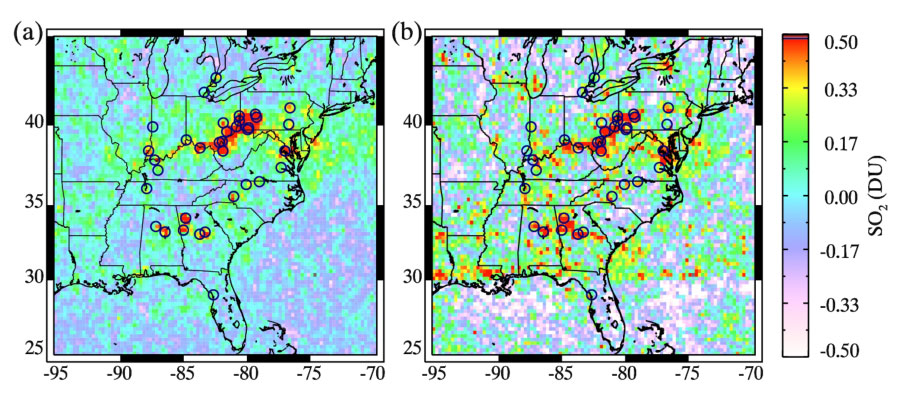Sulfur dioxide (SO2), emitted from both man-made and volcanic activities, significantly impact air quality and climate. Advanced sensors including the Ozone Monitoring Instrument (OMI) flying on NASA's Aura spacecraft have been employed to measure SO2 pollution. This however remains a challenging problem owing to relatively weak signals from most anthropogenic sources and various interferences such as ozone absorption and stray light.
We have developed a fundamentally different approach for retrieving SO2 from satellites. Unlike existing methods that attempt to model different interferences, we directly extract characteristic features from satellite radiance data to account for them, using a principal component analysis technique. This proves to be a computationally efficient way to use hundreds of wavelengths available from OMI, and greatly decreases modeling errors.
This new algorithm will significantly improve the SO2 data quality from the OMI mission. Once applied to other sensors, it will enable the production of consistent long-term global SO2 records essential for climate and air quality studies.

Figure: Monthly mean SO2 maps over the Eastern U.S. for August 2006 generated using (a) the new algorithm and (b) the operational algorithm. Circles represent large SO2 sources (e.g., coal-fired power plants) that emit more than 70,000 tons of SO2 annually. Colors represent the amount of SO2 in the atmospheric column above the surface in Dobson Unit (DU). 1 DU means 2.69 x 1016 SO2 molecules above a surface of 1 cm2 . Because the SO2 signals from anthropogenic sources are relatively weak, small errors in the estimated interferences (e.g., ozone absorption) may lead to substantial biases in the retrieved SO2. Negative values can arise when, for example, the contribution from ozone absorption in the SO2 spectral window is only slightly overestimated. As shown above, the negative retrieval biases become much smaller in the new algorithm.
Technical Description of Figures:
Figure: (a) Monthly mean SO2 over the eastern U.S. for August 2006 retrieved using our new principal component analysis (PCA) algorithm. Data were gridded to 0.25o x 0.25o . Pixels outside the center 50 OMI CCD detector rows, or with radiative cloud fraction > 0.3 or slant column O3 > 1500 DU are excluded. Gray-shaded grid cells have less than 5 measurements during the month. (b) Same as in (a) but for the operational OMI L2 PBL SO2 data. Both retrievals assumed the same ozone, SO2, and temperature profiles, as well as the same surface albedo, surface pressure, and solar zenith and viewing zenith angles. This allows a fair intercomparison between the new and operational algorithms. Smaller noise and less artifacts in the new retrievals allow large point SO2 sources to be more clearly distinguished. Smaller stationary SO2 sources may also be detected by the new PCA algorithm, but likely will require data averaging over a longer period of time.
Scientific significance:
The reduced noise and low biases in SO2 retrievals achieved in the new algorithm will allow SO2 pollution to be monitored at much greater temporal resolution and will enable the detection of smaller emission sources. This can be particularly important in light of the recent reduction in SO2 emissions in many regions around the world, including the U.S. The new algorithm can also minimize the differences between SO2 data records from different satellite sensors, making it possible to produce consistent long-term datasets necessary for climate research. Finally, the new algorithm offers a framework to efficiently utilize the rich spectral information from the state-of-the-art space-borne spectrometers, with minimal required additional computation. Unlike the existing methods that attempt to model different interferences such as ozone absorption and stray light, we directly extract characteristic features from satellite radiance data to account for them, using a principal component analysis technique. This reduces modeling errors and makes the algorithm much faster. It may also be employed to retrieve several other species such as formaldehyde (HCHO).
Relevance for future science and NASA missions:
The new algorithm has been proposed to reprocess data from the Aura OMI mission. It can be applied to NPP and future JPSS OMPS instruments to ensure SO2 data continuity from the EOS era. It can also help extend satellite SO2 data records if applied to other current and future NASA and European missions such as TEMPO, GEO-CAPE, TROPOMI and GOME-2. TEMPO is the first selected NASA EVI instrument and will be launched on a geostationary platform near the end of the decade.
Data Sources:
NASA/KNMI OMI L1B radiance data and L2 PBL SO2 and total O3 data (https://disc.gsfc.nasa.gov/).
References: Li, C., J. Joiner, N. A. Krotkov, P. K. Bhartia (2013), A fast and sensitive new satellite SO2 retrieval algorithm based on principal component analysis: Application to the Ozone Monitoring Instrument, Geophysical Research Letters, 40, doi:10.1002/2013GL058134. (https://onlinelibrary.wiley.com/doi/10.1002/2013GL058134/abstract)
12.30.2013